در این درس یک مکالمه درباره شطرنج به زبان انگلیسی داریم. پدر بابی می خواهد به او شطرنج را یاد بدهد، هر چند بابی در انتها هیچ علاقه ای به بازی شطرنج نشان نمی دهد! با این حال این مکالمه می تواند موقعیتی باشد تا بیشتر درباره کلمات و اصطلاحات شطرنج به انگلیسی با شما صحبت کنیم. دقت کنید فقط دانستن معنی مهره های شطرنج به انگلیسی کافی نیست، بهتر است عبارات و افعالی که در کنار این واژه ها به کار می رود را نیز یاد بگیرید. سعی می کنیم در اینجا اصطلاحات شطرنج به انگلیسی را به صورت کامل به شما عرضه کنیم.
🗣 Playing Chess (شطرنج بازی کردن)
Daddy: Bobby! Come here, look what I got you!
بابی! بیا اینجا، ببین چی برات آوردم!
Bobby: What is that?
اون چیه؟
Daddy: A chess board! Daddy is going to teach you how to play!
یک صفحه شطرنجه! بابایی می خواد بهت یاد بده چطور بازی [اش] کنی!
Bobby: Cool!
خوبه!
Daddy: Ok, each player gets 16 pieces.
خب، هر بازیکن 16 تا مهره داره.
You can be the white ones and I’ll play with the black pieces.
تو می تونی با مهره های سفید بازی کنی و من هم با سیاه.
Now in the front, you set up the pawns.
حالا در جلو، مهره های پیاده رو میچینی.
Those are the least valuable pieces and can only move one space forward.
اونها کم ارزشترین مهره ها هستند و فقط می تونند یک خانه به جلو بروند.
When you are about to capture another piece, it can move one space diagonally.
وقتی بخواهی یک مهره دیگر رو بزنی، می تونن یک خانه به صورت اریب حرکت بکنند.
Bobby: What about all these other pieces?
بقیه مهره ها چی؟
Daddy: See this one that looks like a tower? It’s called the rook.
این رو میبینی شبیه به یک قلعه می مونه؟ به این میگن رخ.
The one with the tall hat is called the bishop.
مهره با کلاه بلند فیل نامیده میشه.
See this little horsey? This is called the knight, it’s a very important piece so it’s best to not let your opponent capture it.
این اسب کوچولو رو می بینی؟ این مهره اسبه، اون خیلی مهره مهمیه پس بهتره نگذاری حریفت بزنتش.
Bobby: And these two? They are husband and wife?
و این دو تا چی؟ زن و شوهر هستند؟
Daddy: That’s right! That’s the queen and that’s the king.
آره درسته! اون وزیر (ملکه) است و اون یکی هم شاه.
If the other player captures your king, he will say ”Check Mate” and the game is over!
اگه حریفت* شاه تو رو بزنه، میگه “کیش و مات” و بازی تموم میشه!
Doesn’t this sound fun?
باحال نیست؟
Bobby: Nah! This is boring!
نه! حوصله سر بره!
I’m gonna go play Killer Zombies on my PlayStation!
من میرم زامبی های قاتل رو روی پلی استیشنم بازی کنم!
🗝️ لغات انگلیسی مهم مکالمه
🔹 diagonally: به صورت اریب
🔹 set up: چیدن، برپا کردن، آماده کردن برای استفاده
🔹 valuable: با ارزش
🔹 capture: گرفتن، ستاندن
🔹 pawn: مهره پیاده
🔹 boring: حوصله سر بر
🔹 Check Mate: کیش و مات
🔹 queen: مهره وزیر
🔹 knight: مهره اسب
🔹 bishop: مهره فیل
🔹 king: مهره شاه
🔹 chess: شطرنج
🔹 rook: رخ
🎯 نکات درس
نام مهره های شطرنج به انگلیسی
ابتدا نام تمام مهره های شطرنج را به انگلیسی به طور کامل برای شما معرفی می کنیم :
Queen

به مهره وزیر در انگلیسی Queen (ملکه) می گویند. در واقع ما در زبان فارسی از از عنوان شاه و وزیر استفاده می کنیم (که اصولا وزیر مرد است). این بخاطر ریشه های تاریخی در ایران است که در کنار شاه، همیشه نقش پررنگ یک وزیر کاربلد دیده می شده است. اما در انگلیسی به این دو مهره در واقع شاه و ملکه می گویند. حرف معرف این مهره Q است.
Rook

به مهره رخ یا قلعه در انگلیسی Rook می گویند. خود واژه Rook در انگلیسی معنی ندارد و از کلمه رخ فارسی ریشه گرفته است. دقیقا معنی و ریشه کلمه رخ را در فارسی ما نمی دانیم اما می دانیم که هم معنی قلعه است. شکل ظاهری رخ هم شبیه قلعه ها است. حرف معرف این مهره R است.
Knight

واژه Knight به معنی شوالیه است و این واژه ای ایست که برای مهره اسب در شطرنج در انگلیسی به کار می رود. در واقع شوالیه ها همیشه سوار بر اسب بوده اند. حرف دوم Knight یعنی N را به عنوان حرف معرف این مهره استفاده می کنند. در فارسی به این مهره اسپ (اسب) گفته می شود.
Bishop

این مهره در اصل در فارسی پیل (یا عربی آن فیل) نامیده می شده است و همچنان هم در فارسی با همین اسم شناخته می شود. بریدگی روی سر مهره در واقع برای نمایش عاج فیل است. وقتی شطرنج در اروپا معروف شد، بیشتر عناوین مهره ها نه مانند زبان فارسی بر اساس زمین جنگ، بلکه بر اساس محیط پادشاهی نامگذاری شدند (مانند شوالیه به جای اسب). نام مهره فیل در شطرنج هم به انگلیسی، به خاطر شباهت این مهره با کلاه اسقف ها و نیز نقش آنها در درباربه اسقف یا Bishop تغییر نام داد.
Pawn

در انگلیسی به مهره پیاده یا سرباز Pawn می گویند. واژه Pawn مانند Rook در انگلیسی معنی ندارد و ریشه آن به زبان لاتین و بعد واژه سرباز پیاده در فرانسوی بر می گردد.
اصطلاحات و عبارات مهم شطرنج به انگلیسی
در اینجا لیستی از مهمترین اصطلاحات و عباراتی که در شطرنج به زبان انگلیسی به کار می رود را برای شما جمع آوری کرده ایم :
🔹 Check:
کیش، زمانی که به مهره شاه حمله شود کیش رخ می دهد.
🔹 Double Check:
کیش دوبل یا دوگانه، وقتی همزمان دو مهره به یک شاه حمله کنند کیش دوگانه اتفاق می افتد. از آنجایی که حذف یا قراردادن مانع روی یکی از این مهره ها نمی تواند جلوی کیش مهره دیگر را بگیرد، در وضعیت کیش دوگانه باید به اجبار مهره شاه را حرکت داد.
🔹 Checkmate:
کیش و مات
🔹 Illegal move:
حرکتی که در شطرنج پذیرفته و مجاز نیست.
🔹 Draw:
وضعیت مساوی، زمانی که هیچکدام از طرفین، مهره کافی برای مات کردن طرف مقابل نداشته باشد تساوی رخ می دهد. همچنین تساوی می تواند به صورت توافقی بین هر دو طرف نیز رخ دهد. در صورت تکرار یک حرکت توسط هر دو طرف یا بازی طولانی که در آن هیچ تغییری در بازی ایجاد نشود نیز تساوی رخ می دهد.
🔹 Stalemate:
پات : زمانی که یک طرف هیچ مهره ای که بتواند حرکت کند نداشته باشد و شاه او نیز در حالت کیش (و مات) نباشد و در صورت حرکت شاه به حالت کیش برود، بازی پات می شود و نتیجه مساوی اعلام می شود.
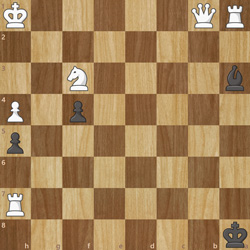
🔹 Capture:
گرفتن یا زدن مهره، وقتی با یک مهره به مهره دیگر حمله و آن را می گیریم.
🔹 Castling:
عمل قلعه رفتن.
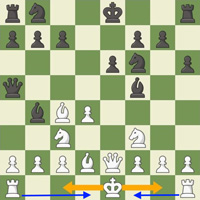
🔹 En passant:
حرکت آن پاسان. این حرکت در بین عموم مردم خیلی شناخته شده نیست. وقتی یک سرباز در اولین حرکت خود دو خانه پیش برود و در کنار یک سرباز دیگر قرار بگیرد، این سرباز می تواند آنرا به صورت مورب بزند. این حرکت برای جلوگیری از فرار سربازها از کنار هم به وجود آمده است.
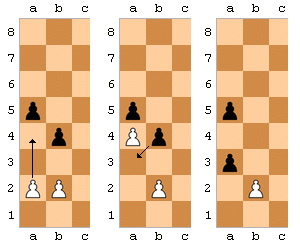
🔹 Pin:
آچمز. این واژه ترکی به معنای میخکوب شدن است و زمانی که یک مهره برای دفاع از یک مهره ارزشمندتر مجبور است که حرکت نکند، می گویند آچمز شده است.
🔹 Absolute pin:
آچمز مطلق، زمانی که مهره ای آچمز شاه خود باشد به آن آچمز مطلق می گویند.
🔹 Fork:
چنگال، به زمانی که یک مهره همزمان به دو مهره حمله می کند می گویند. چنگال اسب به خصوص در این میان بسیار معروف است (شاید به خاطر اینکه پیش بینی آن برای آماتورها سختتر است). همچنین چنگال پیاده به خصوص وقتی دو مهره ارزشمند را درگیر می کند و نیز چنگال فیل وقتی رخ و وزیر را چنگال می کند جزو چنگال های معروف هستند.
🔹 Activity:
وقتی یک مهره آزادی عمل برای حرکت داشته باشد اکتیویتی دارد.
🔹 Adjournment:
قطع و ادامه بازی در زمان دیگر. این اتفاق نادر البته در قدیم بیشتر اتفاق می افتاد و الان تقریبا به ندرت پیش می آید.
🔹 Advantage :
برتری، وقتی یک طرف موقعیت های بهتری نسبت به طرف مقابل داشته باشد.
🔹 Development:
وقتی مهره ها از موقعیت اولیه خود حرکت کنند و در موقعیت های بهتری قرار بگیرند می گویند آنها توسعه پیدا کرده اند.
🔹 File:
به ستونهای خانه های شطرنج در انگلیسی فایل می گویند. این ستونها از a تا f نامگذاری شدهاند.
🔹 Open File:
به ستونی که هیچ پیاده ای در آن از هر دو رنگ نباشد ستون باز می گویند.
🔹 Semi-Open File:
ستون نیمه باز، ستونی که تنها یک سرباز در آن باشد.

🔹 Rank:
هر سطر از خانه های شطرنج را در انگلیسی rank می گویند. ردیف ها از 1 تا 8 شماره گذاری شده اند (1 برای سفید)

🔹 Back Rank:
ردیف اول برای هر طرف. (ردیفی که در ابتدای بازی مهر های اصلی در آن قرار دارند)
🔹 Battery:
قرار دادن دو مهره یا بیشتر در یک ردیف، ستون یا اریب برای حمله. معمولا باتری توسط رخ ها و وزیر انجام می شود. همچنین وزیر و فیل هم می توانند یک باتری ایجاد کنند.
🔹 classical (game):
بازی شطرنج در فرمت زمانی کلاسیک. این نوع بازی معمولا بسیار طولانی است و معمولا بالای یک ساعت برای هر بازیکن زمان وجود دارد.
🔹 Rapid:
بازی های سرعتی رپید که معمولا بین 10 تا 15 دقیقه (کمتر از 60 دقیق) زمان برای هر طرف وجود دارد
🔹 Blitz:
فرمت زمانی بلیتز، بازی های سرعتی که معمولا 5 دقیقه (تا حداکثر ده دقیق) برای هر طرف زمان وجود دارد.
🔹 Bullet:
بازی های فوق سرعتی، معمولا هر طرف بین 1 تا 3 دقیقه زمان برای بازی دارند.
🔹 Book move:
حرکت کتابی به حرکتی می گویند که طبق گشایش های از قبل مطالعه شده انجام می شود.
🔹 Opening:
گشایش یا شروع بازی به حرکات اولیه در شطرنج می گوید. بیشتر گشایش ها در حال حاضر (تا چندین حرکت) مطالعه شده اند و تدریس می شوند و اسامی خود را دارند. ( مثل Queen’s Gambit)
🔹 Blunder:
سوتی، حرکتی بسیار بد که امتیاز فوق العاده ای به طرف مقابل می دهد.
🔹 Discovery:
وقتی یک حمله با حرکت دادن یک مهره توسط مهره ای دیگر انجام شود به آن Discovery یا discovered attack می گویند. به عنوان مثال در تصویر زیر با حرکت اسب به خانه c7، یک کیش به شاه سیاه داده می شود و دو حمله کشف شده به وزیر و رخ سیاه ایجاد می شود.

🔹 Pawn structure:
به ساختار سربازها در بازی گفته می شود
🔹 Isolated pawn:
پیاده ها در شطرنج می توانند به صورت مورب همدیگر را حمایت کنند. به پیاده ای که در ستونهای راست و چپ خود هیچ سربازی جهت حمایت نداشته باشد سرباز ایزوله می گویند.
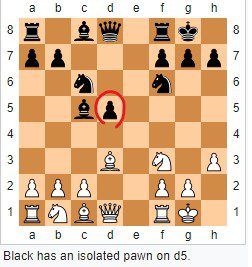
🔹 Passed pawn:
به سربازی که هیچ یک از سربازهای طرف روبرو نتواند به آن حمله کند پیاده رونده می گویند. این پیاده موقعیت بهتری برای ترفیع دارد
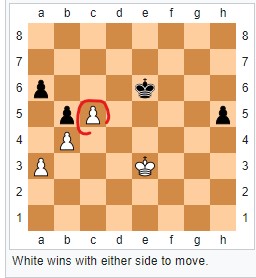
🔹 Doubled pawn:
پیاده های دوبل به پیاده های می گویند که هر دو در یک ستون قرار داشته باشند. از آنجایی که حرکت گرفتن توسط پیاده ها به صورت مورب است، وقتی یک پیاده یه مهره را بگیرد، به ستون کناری می رود و ممکن است یک پیاده دیگر عقب تر یا جلوتر از آن در آن ستون باشد. در این صورت پیاده دوبل ایجاد می شود.

🔹 minor piece:
مهره های کوچک یا سبک، به مهره های فیل و اسب می گویند.
🔹 major piece:
مهره های بزرگ یا سنگین، به وزیر و رخ می گویند.
🔹 Exchange:
تبادل دو مهره معمولا هم ارزش را می گویند. یعنی هر دو طرف یک مهره از طرف مقابل بگیرند.
🔹 Up the Exchange:
این اصطلاح وقتی به کار می رود که در تبادل مهره های کوچک و بزرگ به طور ویژه بین رخ و اسب یا فیل، یک طرف برنده باشد. یعنی یک طرف در ازای زدن رخ طرف مقابل، اسب یا فیل خود را بدهد (که ارزش کمتری دارد). به این تبادل The exchange می گویند (به the دقت کنید) و با تبادل یا exchange متفاوت است. Up در اینجا به معنی دست بالا داشتن است و به کسی که این تبادل به نفع او بوده می گویند.
🔹 FIDE:
فدراسیون بین المللی شطرنج، اختصار از کلمه فرانسوی Fédération Internationale des Échecs
🔹 Forfeit:
حذف یا باخت خودکار، وقتی بازیکنی به بازی نرسد و حضور پیدا نکند بازنده محسوب می شود.
🔹 Material:
به ارزش دارایی های (مجموع مهره های) یک طرف می گویند. کسی که مجموع مهره های پیاده و سواره اش بیشتر باشد material advantage دارد. وقتی یکی از طرفین برتری کسب می کند winning material استفاده می شود.
🔹 Promote:
ترفیع پیاده، وقتی یک پیاده به ردیف هشتم (انتهایی) می رسد به یکی از مهره های سواره (وزیر، رخ، اسب، فیل) ترفیع پیدا می کند.
🔹 Queening:
ترفیع یک پیاده به وزیر را می گویند.
🔹 Repetition (threefold repetition):
نوعی از تساوی که با سه بار تکرار دو حرکت توسط دو طرف اتفاق می افتد.
🔹 Resigns:
تسلیم، واگذاری، وقتی یک طرف با خواست خود بازی را واگذار می کند
🔹 compensation:
جبران، عوض، زمانی که بازیکن در ازای از دست دادن مهره، مهره دیگر یا موقعیت مناسبی به دست میاورد.
🔹 tempo:
تمپو در شطرنج به هر حرکت می گویند. وقتی بازیکنی یک حرکت اضافه می کند تمپو از دست می دهد.
🔹 threat:
خطر، حرکت یا برنامه ای که بتواند به بازیکنی آسیب وارد کند. این خطر می تواند کیش و مات، گرفتن متریال، یا موقعیت خیلی بهتر باشد.
قانون دست به مهره حرکت، وقتی بازیکنی به یک مهره خودش دست بزند باید حتما آن را حرکت دهد مگر اینکه آن مهره هیچ حرکت مجازی نداشته باشد. وقتی مهره ای را در جایی قرار دهد و دستش را از روی آن بردارد آن مهره باید در آن خانه باقی بماند مگر اینکه حرکت مجاز نباشد. همچنین اگر بازیکنی یکی از مهره های حریف را لمس کند، در صورت امکان باید حتما آن را بگیرد. برای اصلاح یک مهره باید قبل از آن عبارت “تنظیم می کنم” یا “I adjust” گفته شود.
🔹 Zugzwang:
حرکت اکراهی، وقتی یک بازیکن نوبت حرکتش باشد، اما هر حرکتی که بکند موقعیت او را تضعیف کند به آن حرکت اکراهی یا zugzwang می گویند که ریشه آلمانی دارد.
🔹 Sacrifice:
قربانی کردن، وقتی یک بازیکن مهره ای را قربانی می کند تا در ازای آن موقعیت برتری کسب کند
🎧 پادکست صوتی آموزش انگلیسی
متن پادکست
Hello everyone, my name is Marco.
Hi guys, my name is Katherine.
And today we’re going to be looking at another lesson as part of our sports series and this time, well it’s a debate, is it a game or is it a sport?
Oh, it’s a sport, you have to work your mind.
Yeah, so we’re looking at chess, a very old, very popular sport, very difficult to play as well.
It takes a lot of practice and believe me, it’s frustrating at the beginning and I’m still kind of in the beginning intermediate stages, but yeah, it takes a lot of practice
and it takes a lot of time to familiarize yourself with the rules.
So we’re going to be learning a little bit more about the pieces and the rules today.
Okay, perfect, so we’re not going to preview anything, let’s listen to the dialogue for the first time and then we’ll come back and talk about the sport.
Bobby, come here, look what I got you.
What is that?
A chess board, daddy’s going to teach you how to play.
Cool.
Okay, each player gets 16 pieces, you can be the white ones and I’ll play with black pieces.
Now in the front, you set up the pawns.
Those are the least viable pieces and can only move one space forward.
When you’re about to capture another piece, it can move one space diagonally.
What about all these other pieces?
See this one, it looks like a tower, it’s called the rook, the one with the tall hat is called the bishop.
See this little horsey, this is called the knight.
It’s a very important piece, so it’s best not to let your opponent capture it.
And these two, they are husband and wife.
That’s right, that’s the queen and that’s the king.
If the other player captures your king, he will say, checkmate, and the game is over.
Doesn’t this sound fun?
Nah, this sounds boring.
I’m going to go play killer zombies on my PlayStation.
Alright, so the kid is obviously not very interested in learning how to play chess.
Not at all.
And now the art of these kind of slower games might be replaced very soon by video games.
Yeah, I guess it doesn’t really appeal to a little 9 year old or 10 year old instead of playing something like this versus yeah, shooting.
Yeah, exactly.
But it’s a very great game, it’s very difficult like we mentioned, so we’re going to look at the name of the pieces and the rules that are related to these pieces in language takeaway.
Language takeaway.
Well, the first one, you might have heard before because this is a word that is often used in strategy in general.
So the word pawn.
A pawn.
A pawn usually means something that is not very important that you can use to distract an opponent.
Alright, so on the chess board you have eight pawns.
So these are the ones that you have the most, but their movement is very limited.
So they can only move two spaces forward on the first move, right?
Right, or one space after that.
One space forward.
And only when it’s going to capture another piece can it move diagonally.
Alright, so you can’t just go diagonally, you have to go forward until you’re going to take another person’s piece to capture it and to go diagonally.
But a pawns is funny, you can also use this word when you’re talking about other things like he used her as a pawn in his little game, so you want to make an analogy, you want
to make a comparison from life to these games, you can use the word pawn.
Pawn.
Very good.
Now moving on to the other pieces on the chess board, on the very far ends of the board you have the rook.
Okay, you’ve got two of these and they kind of look like towers from a castle.
And it’s a very, well they’re very important pieces and actually my favorite pieces because they’re not very important at the beginning of a game, but at the end of a game, boom,
boom, boom, you can do a lot of damage because they can go anywhere in straight lines.
Right, so they can go forward, backwards and to the sides as many spaces as they want.
The whole board if they want.
The whole board.
Yeah, so easy pieces to forget about at the beginning but they’re very important.
And now next to the rook we have the bishop.
Because this is very different from the rook because the bishop can also go anywhere but they can only go diagonally.
Right, so only diagonally, they can also move forward directions but diagonally, right?
Exactly.
They can go forward and backward but it has to be in a diagonal slanted line.
And now next to the bishop we have the knight.
Ooh, the knight, so he’s the one galloping on the horse like those old stories of King Arthur we used to hear.
But the knight can go in an L shape and I’ve never understood this.
It’s weird, so it can move two spaces forward and then one to the right or one to the left or it can move two spaces to the right and then one forward.
So it’s very strange but it always has to move three spaces and in the shape of an L.
So I thought maybe he was the drunken piece.
He can go forward a little bit then tum tum, he kind of moves to the side.
Right, so that’s the knight.
It’s actually a very, very important piece as well.
And now the two main pieces maybe of the chess board, the queen and king.
So the king is kind of sad.
He can only move one space but the queen is really the killer because she can do anything she wants.
This is interesting, right?
Why did they make it like that?
The queen can move as many spaces as she wants in any direction while the king can do the same in his direction he wants but only one space.
I think there’s some similarity between real life now is like the queen can do anything she wants and the king can kind of do whatever he wants.
Well maybe it has to do with the fact that he has to stay put and represent the country and she can move around and move behind the scenes and has a little bit more mobility.
Maybe.
So, but in the end, the most important piece is the king, right?
Once the king is captured, the game is over.
Exactly.
So let’s listen to today’s dialogue one more time and slow it down a bit and find out if the boy understood any of these rules.
Bobby, come here.
Look what I got you.
What is that?
A chess board.
Daddy’s gonna teach you how to play.
Cool.
Okay, each player gets 16 pieces.
You can be the white ones and I’ll play with the black pieces.
Now in the front, you set up the pawns.
Those are the least viable pieces and can only move one space forward.
When you’re about to capture another piece, it can move one space diagonally.
What about all these other pieces?
See this one that looks like a tower?
It’s called the rook.
The one with the tall hat is called the bishop.
See this little horsey?
This is called the knight.
It’s a very important piece, so it’s best not to let your opponent capture it.
And these two?
They are husband and wife.
That’s right.
That’s the queen and that’s the king.
If the other player captures your king, he will say, checkmate, and the game is over.
Doesn’t this sound fun?
Nah, this sounds boring.
I’m going to go play killer zombies on my PlayStation.
Alright, we’re back and now why don’t we explain a couple of these phrases that we also use to explain the pieces, but let’s look at some of these more in-depth now in
Fluency Builder.
So Marco, one of the first phrases that we heard was the phrase to move diagonally or a diagonal line, and so the pawns can sometimes do this and the bishop can do this, but what
does it mean to move diagonally?
Okay, so basically a diagonal line is not a line that goes straight up, right?
Straight up to the sky, for example, or to the side, right?
It goes at an angle, so it’s maybe going at 45 degrees or 30 degrees, so that’s a diagonal movement or diagonal line.
The next phrase we have is very strange, and this one you might hear from parents or children.
He says a little horsey.
Little horsey, so in many languages we have ways of breaking down words or adding to words to make them sound cuter, and this is one of those cases.
So for example, little puppy or little kitty or kitten, these are words to make things sound cuter, so in this case, horse becomes horsey.
So, I want to ride the horsey.
It’s a cute way of saying I want to ride the cute horse.
Mommy, mommy, I want to ride the horsey.
Exactly.
So baby talk often involves having these rhyming words, mommy, horsey, doggy, puppy.
A doggy, exactly.
Very good.
So it’s a cute way of saying something, and now when we were talking about the chess pieces, when another piece takes or gets a piece, you say it captures it.
Okay, we say capture because, well maybe it’s a bit nicer than killing it, but capture means taking and keeping for yourself.
So we have a very popular game in America called capture the flag.
Right, where you have to take each other’s flag, right?
You’re stealing, essentially.
So yeah, this is the term that is used in chess to capture another piece.
Sometimes like for example in Spanish, we actually say like to eat the other piece.
Really?
Yeah, you eat it.
Weird.
Well, we’re a little bit more tame in those English speaking countries, but to capture is a very important phrase, and you’re going to hear that in the news as well, because
you can capture a person.
You can capture a criminal.
All right, and the final word and the way that you end a game of chess, you say checkmate.
Checkmate.
So the game’s over, checkmate.
Well, there’s two things that can happen at the end of a game, and well, only one thing can happen at the very end of a game, but you’re going to hear these two phrases.
The one is check, and the other is checkmate.
So check means that I can take your king if I want to, move.
Right, it’s in danger.
It’s in danger, but checkmate is the end all.
This means this is the very, very last part of a game where you cannot do anything.
I’ve trapped you, and I win.
Right, very good.
So the game is over when somebody says checkmate.
Why don’t we listen to this dialogue for the last time, and then we’ll come back and talk a little bit more about this very interesting game.
Bobby, come here.
Look what I got here.
What is that?
A chess board.
Daddy’s going to teach you how to play.
Cool.
Okay, each player gets 16 pieces.
You can be the white ones, and I’ll play with the black pieces.
Now in the front, you set up the pawns.
Those are the least viable pieces, and can only move one space forward.
When you’re about to capture another piece, it can move one space diagonally.
What about all these other pieces?
See this one?
It looks like a tower.
It’s called the rook.
The one with the tall hat is called the bishop.
See this little horsey?
This is called the knight.
It’s a very important piece, so it’s best not to let your opponent capture it.
And these two, they are husband and wife.
That’s right.
That’s the queen, and that’s the king.
If the other player captures your king, he will say, checkmate, and the game is over.
Doesn’t this sound fun?
Nah.
This sounds boring.
I’m going to go play killer zombies on my PlayStation.
Pop quiz, Marco.
The word check, and the word mate.
They both have meanings in English, but put together, where does this phrase come from?
What could it possibly mean?
I have no idea.
Why don’t you tell us?
Because I seriously don’t know where it comes from.
Okay, well, this is actually very interesting, because I looked it up, and I had no idea either, because we’ve always just said this, and it doesn’t really make sense.
So I looked it up on the internet, and I discovered that the game of chess is actually a very ancient game, and it did not come from England, it did not come from France, it actually came
from Persia.
And in Persian, there are some words that kind of became the English words checkmate that mean the king is captured, or the king is defeated.
So that’s what it means.
It doesn’t mean the king is dead.
No, it doesn’t mean that he’s dead, it means that he’s been taken.
And so over time, the Persian word went into Arabic, and Arabic became French, and English, and then now we say checkmate.
Checkmate, okay, interesting.
And this is a very interesting word, and I’m sure everybody that’s listening has a different translation for it in their own language.
I know, for example, that in Spanish, we would say hakemate.
Hakemate.
Right, so I guess like hake is something in Czech, it’s in danger, and then mate, kind of like kill.
So maybe it’s probably not translated properly, because as you mentioned, it should mean defeated or captured, not killed.
Bye.
Thank you.





